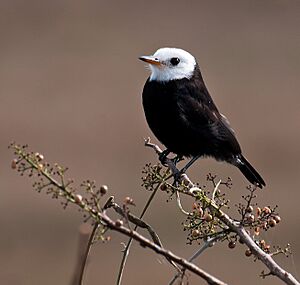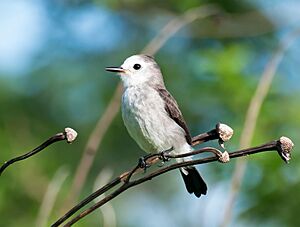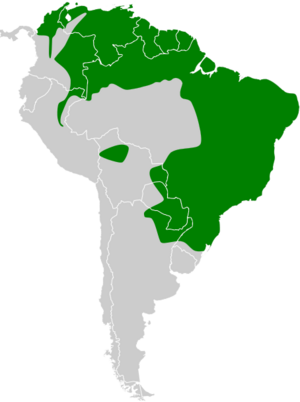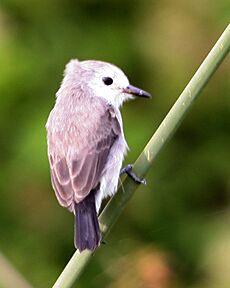White-headed marsh tyrant facts for kids
Quick facts for kids White-headed marsh tyrant |
|
|---|---|
 |
|
| Male in São Paulo, Brazil | |
 |
|
| Female in São Paulo, Brazil | |
| Conservation status | |
| Scientific classification | |
 |
|
| Synonyms | |
|
The white-headed marsh tyrant (Arundinicola leucocephala) is a small passerine bird. It belongs to the tyrant flycatcher family. This bird is the only species in its genus, Arundinicola. You can find it in tropical South America, from Colombia, Venezuela, and Trinidad all the way south to Bolivia, Argentina, and Paraguay.
Contents
What Does the Marsh Tyrant Look Like?
An adult white-headed marsh tyrant is about 12.7 centimeters (5 inches) long. It weighs around 15 grams, which is about as much as three nickels.
The male bird is mostly brown-black. But it has a large, bright white head and a yellowish lower beak. The female bird looks a bit different. Her upper body and wings are brown, and her tail is black. Her belly, sides of her head, and the front of her head are a dull white color.
This bird is usually quiet. However, its call is a sharp sedik sound.
Where Do They Live?
White-headed marsh tyrants like to live in wet places. You can find them in marshy grasslands, areas with lots of reeds, and near the edges of mangrove swamps.
What Do They Eat?
These birds are insect eaters! They often wait on a low branch or plant stem near water. From there, they quickly fly out to catch insects. After catching their meal, they usually fly right back to their perch.
They often pick insects off plants. But they also catch them right out of the air. Sometimes, they even grab insects from shallow water. Their favorite foods include dragonflies, grasshoppers, froghoppers, and beetles.
Reproduction and Family Life
The white-headed marsh tyrant builds a special nest. It's shaped like an oval ball and is made of grasses and other plant materials. The inside is lined with soft feathers. It has a small entrance on the side, like a porch. They usually place their nest at the end of a branch, often hanging over or near water.
Both the male and female birds take turns sitting on the eggs. A typical nest has two or three creamy-white eggs. These eggs usually have a few brown spots. Sometimes, other birds called Cowbirds lay their eggs in the marsh tyrant's nest. This means the marsh tyrant might end up raising cowbird chicks instead of their own!
Is the Marsh Tyrant in Danger?
The IUCN (International Union for Conservation of Nature) keeps track of how many animals are left in the world. They do not think the white-headed marsh tyrant is in danger right now. However, in some places, their homes are getting smaller or less healthy. If this continues, local groups of these birds might disappear.



